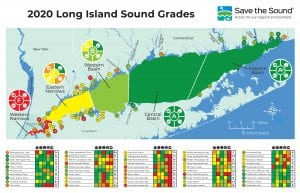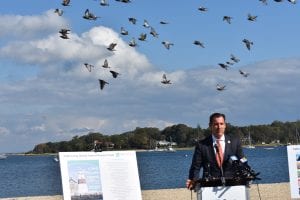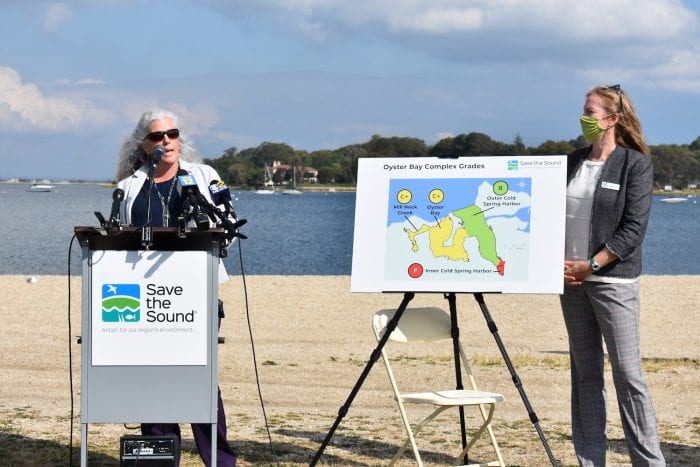A new report by a regional environmental nonprofit says a little under half of all bays on either side of the Long Island Sound were given a poor-to-failing grade. It’s a continuing problem, but more and more local groups are stepping up to dedicate their time and energy to trying to maintain the water as a strong habitat.
At a press conference Tuesday, Oct. 6, Save the Sound, a Connecticut-based environmental nonprofit funded by a U.S. Environmental Protection Agency grant, released its biennial 2020 Long Island Sound Report Card that described the general health of 50 bays from Long Island and Connecticut based on the previous year’s data.

Officials and experts revealed that, of those monitored, Suffolk County North Shore harbors were largely better off than those in Connecticut, but several still had issues. Port Jefferson, at least the outer and middle portions of the harbor, was ranked in the top 10 most healthy, with experts saying it most likely has to do with how well the harbor flushes daily.
Meanwhile sites like Northport and Centerport harbors were ranked C- and C respectively. Northport Harbor received a F grade for its excess of chlorophyll, a measurement of how much microalgae is in the water, and its low level of dissolved oxygen, an important factor for the health of fish. Centerport had similar difficulties, but also had issues of excessive seaweed accumulation.
Perhaps the most concerning of North Shore Suffolk County’s waterways was the innermost part of Cold Spring Harbor which received F grades in chlorophyll, seaweed and dissolved oxygen.
U.S. Reps. Tom Suozzi (D-NY3) and Lee Zeldin (R-NY1) were both present to offer their support of bipartisan funding for this and future studies as well as initiatives to keep local bays clean. Suozzi said in the past four years, the Long Island Sound Caucus has extended the EPA Long Island Sound program to 2023 and increased the $4 million appropriated to the Sound to $21 million. The House has already passed a bill to up that to $30 million, but has not yet been taken up by the Senate.
Zeldin said the low grades of so many bays only emphasizes the need for more federal funding for further studies and additional relief.
“Working across the aisle and across the Sound, we’ve made great progress in preserving this critical waterway, but with nearly half of the waterways measured in this report as receiving a D grade or below, there’s still work to do,” he said.
George Hoffman, a co-founder of the Setauket Harbor Task Force that monitors Port Jeff, also acknowledged a great deal of why the bay has done comparatively well is because of its flushing capacity. Another factor, he said, may be the hundreds of thousands of oysters and shellfish the Town of Brookhaven seeds into the bay. The shellfish do a great job of filtering organic particulates from the water.

Save The Sound’s Unified Water Study program includes 22 organizations covering 50 harbors on both sides of the waterway. Monitoring begins in May and ends in October. The study also looks at the general health state of the Sound itself. It’s long been clear that the closer one is to New York City, the less healthy the water is. The Western Narrows portion of the Sound received an F grade on all marks, while the Eastern Narrows, which runs from Northport to the edge of Hempstead Bay, received a C grade overall. Areas to the east were reported as much healthier in general.
Jamie Vaudrey, an assistant research professor of marine science at the University of Connecticut, said likely the biggest factor for the health of bays in a modern environment is how well the water flushes in and out of the harbor. Water like that trapped into the southernmost tip of Cold Spring Harbor is more impacted by any real increase in nitrogen.
“They just have this large nitrogen burden coming in that’s not being flushed out,” she said. “In systems like that, really pushing down that nitrogen load is important.”
Nitrogen has been called public enemy No. 1 for coastal waters as it’s the leading cause of hypoxia, namely low or depleted oxygen causing major problems for marine life. This can cause fish or other sea creatures to die off and lead to an excess of seaweed or algae. Some of these algal blooms have even been dangerous to animals or humans.
Though Port Jefferson Harbor’s general health was rated high, it too has experienced its share of dangerous algal blooms, including a so-called rust tide back in 2018. Though this specific bloom doesn’t present a threat to human beings, it kills fish quite rapidly. Those who study water quality have become very concerned with how often these blooms have appeared since the early 2000s.
For some of the struggling bays in the Town of Huntington, New York State Sen. Jim Gaughran (D-Northport) called for a funding stream from the federal government on down that can really start to make a dent in Suffolk County’s lack of sewage treatment facilities and get the ball rolling on nitrogen-reducing septic systems, which individually can cost a homeowner $10,000 to $15,000 apiece without government funding.
“People can’t do that on their own — we need tax credits, we need funding,” he said.





